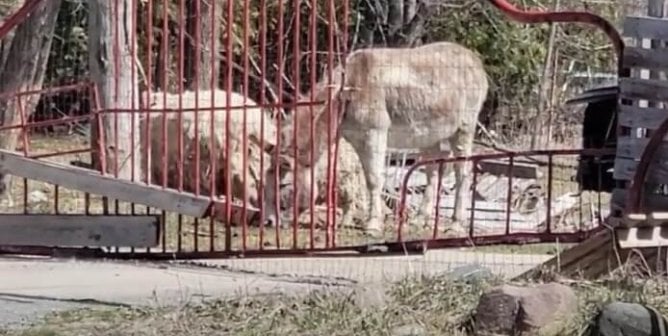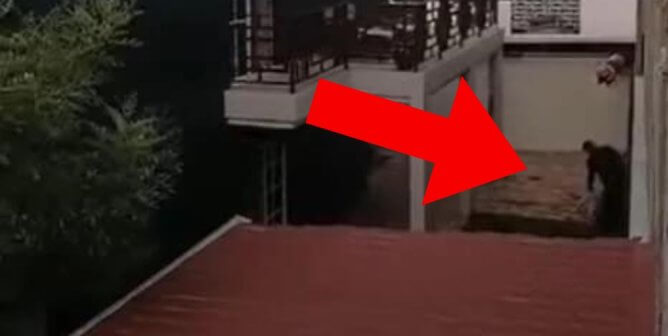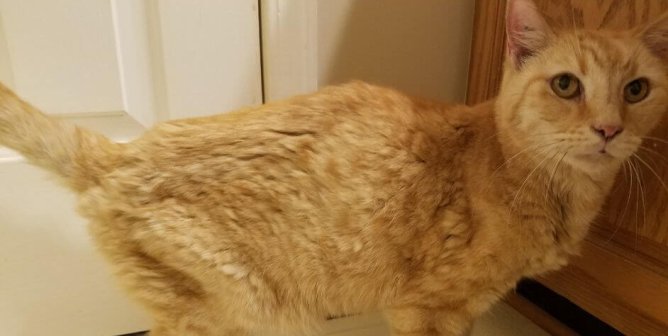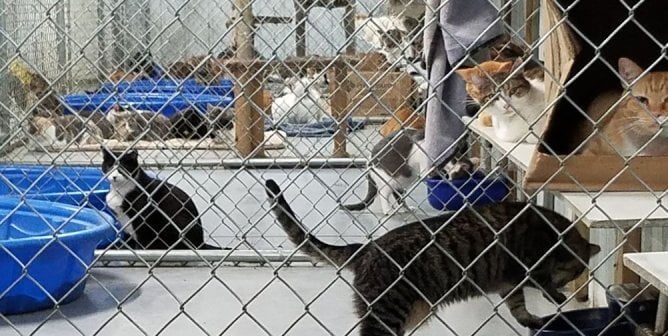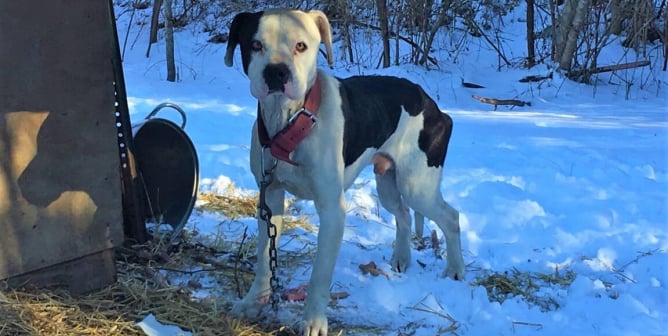Trap, Neuter, Return, and Monitor Programs for Feral Cats: Doing It Right
There are millions of homeless cats in the United States. Addressing this crisis can be overwhelming, and is a difficult and emotional issue for many people. Some groups and individuals advocate so-called “trap, neuter, release” programs, in which cats (who are often quite tame, as opposed to being truly feral or unsocialized) are sterilized and then abandoned outdoors instead of being admitted to animal shelters. But PETA’s experiences—which include countless incidents in which cats experienced prolonged suffering and died in agony because they were forced to fend for themselves outdoors, whether “managed” or not—have led us to question whether these programs are truly in the cats’ best interests.
Homeless cats do not die of old age. Highly contagious diseases are common, as are infected puncture wounds, broken bones, urinary tract infections, internal injuries, attacks by other animals or cruel humans, automobile accidents, and weather extremes or other terrible living conditions, having to scrounge for food, and being considered a “nuisance,” through no fault of their own. Moreover, free-roaming cats—no matter how well-fed they are—terrorize and kill billions of birds and small native mammals in the U.S. every year, animals who are not equipped to deal with these non-native predators.
Having witnessed firsthand the many gruesome fates of homeless cats and of the animals they prey upon, PETA believes the ideal solution lies in preventing cat homelessness in the first place, by passing and enforcing strong responsible guardianship laws, including requirements that cats (and dogs!) be spayed and neutered, licensed and microchipped, and kept indoors or safely contained on their guardian’s property. Homeless cats need—and deserve—to be brought indoors or taken to open-admission animal shelters where they are safe and warm, and have a chance at being adopted into loving homes.
Each situation is different, but it’s never acceptable to feed cats without providing them with medical care, vaccinations, and sterilization surgeries at the minimum. Feeding alone only serves to keep cats in a dangerous situation while also perpetuating the overpopulation crisis and its tragic consequences: the needless suffering and premature deaths of millions of animals every year.
If you’ve determined that you have the time and resources to properly care for a colony of unsocialized (feral) cats, and if the cats are in a safe place (i.e., the climate is temperate and they can be safely contained in a securely enclosed area), please be sure to follow the following minimum guidelines.
Caring for a Feral Cat Colony
The responsibilities of a feral cat caregiver include ensuring that all cats are safely contained on a property where they are welcome, preferably your own. Before caring for cats on someone else’s property, it’s important to get written permission to do so, and have a plan in place for what to do if the property is sold to someone who doesn’t want the cats there or the property owner has a change of heart.
All cats must be humanely captured, sterilized, thoroughly vaccinated, provided with fresh water and food in a sanitary feeding station, given access to shelter, provided with litterboxes (one per cat) that are cleaned twice per day, and treated for illnesses and injuries. A properly managed feral cat colony doesn’t exceed the number of animals legally allowed at any one residence in the jurisdiction in which it is located, is no larger than the caregiver(s) can care for, and is healthy and stable, i.e., no new kittens are born. Only truly feral cats should be added to colonies—tame cats should be cared for indoors, rehomed, or taken to shelters where they have a chance at being reunited with their guardians or adopted into loving indoor-only homes.
- Health
Find a veterinarian who can be somewhat flexible—feral cats don’t always keep their appointments! Consider the costs of each new cat’s needs: spaying/neutering, a full exam, ear and dental cleaning, deworming, feline leukemia and feline AIDS testing, and vaccinations, and the ongoing costs of regular veterinary check-ups, dentals, vaccinations, deworming, and monthly oral flea control (make sure to use only medicines that clearly state that they are for oral administration), and more.
Cats who test positive for leukemia (FeLV) or AIDS (FIV) must be isolated from non-positive cats, or euthanized to prevent them from infecting others. If you decide to keep them in isolation, keep in mind that they require close monitoring and considerable financial resources: These infections can cause a progressive deterioration in a cat’s health. Painful symptoms often include loss of appetite, progressive weight loss, persistent fever, gum and mouth infections, bladder, skin, and upper respiratory infections, persistent diarrhea, seizures and other neurological disorders, and variety of eye conditions. A study found that nearly a quarter of feral cats in one community were positive for one or both of these deadly infections.
Plan your budget depending on the age, health, and number of cats in the colony. Make sure that you can cover daily and routine expenses in addition to unexpected costs for taking care of injuries and illnesses. Local animal shelters and spay/neuter clinics may be able to help with low-cost surgeries and box trap rentals.
If you notice any cats whose behavior or eating habits have changed, who are lethargic, or who have dull eyes, a dull and/or matted coat, or discharge from the nose or eyes—all possible indicators of ill health—retrap them and take them to your vet. It may help to work out a plan in advance so that your vet can provide you with medications for minor health problems.
Stay organized! Maintain veterinary records on and take a photo of each cat, keep track of any problems that they have had, and maintain a list of those who still require sterilization. Ear-tipping (the removal of a quarter-inch off the top of the left ear conducted by a veterinarian during sterilization surgery) will enable you to identify those who have been sterilized. All cats should be microchipped to ensure proper identification in the event of a health crisis or other emergency.
With unsocialized domestic animals depending on you for their every need and safety, it’s critical that you have a plan in place for ensuring the cats’ safety in the event of a natural disaster, or in case something happens to you, the person they depend on. This is another reason why keeping all cats in an enclosed area is so important.
- Food and Water
Feed the cats in a dry, sheltered spot, or build them a covered feeding station. (This can simply be a canopy made out of a large domed trashcan lid held up by four wooden posts.) Locate the feeding station away from sleeping and elimination areas. Feed roughly 5.5 ounces of canned cat food and 2 ounces of dry food per cat each day per cat, and increase that amount during cold weather. If the food is gone in 15 minutes, you might need to increase rations. If there’s still food remaining after an hour, put out less. To keep bugs at bay, grease the outside of food bowls with cooking oil. Remove uneaten food and clean the feeding station every day to avoid attracting other wildlife or irritating human neighbors. Clean, drinkable water must be provided daily, and be available at all times.
If you must be away, find a reliable neighbor, friend, or family member to stand in for you. It’s dangerous and irresponsible (and can be deadly) to leave cats unattended for a few days with a big bowl of food, whether they’re indoors or out.
- Shelter
Feral cats are genetically identical to the cats who share our homes and are no more equipped to withstand freezing temperatures than our own animal companions are. It’s cruel to maintain cats in outdoor-only enclosures in areas with harsh climates (i.e., where temperatures fall below freezing). Even in mild areas, cats desire safe, enclosed shelters where they can hide if they feel vulnerable, and get out of the wind and rain if they can’t be brought indoors. Shelters must be waterproof, windproof, elevated slightly off the ground, and insulated. The shelter should be filled about one-third to one-half full with straw (not hay)—don’t use blankets or carpeting, because they retain moisture. Change the straw a few times a year (more often if needed), and spray or dust the outside of the shelter with a nontoxic flea-control product. (See PETA’s factsheet “Flea Control: Safe Solutions.”) Place shelters in locations that are protected from wind. Keep entrances to shelters clear of debris so that the cats don’t get trapped.
Outdoor enclosures must also be equipped with shaded areas (especially in summer), and should include walkways at different levels, hiding boxes, lounging beds and hammocks, and more to prevent boredom (Some great ideas can be found here.)
Cats living in areas where the winters are cold must be provided with a heated barn or other conditioned structure where they can escape the cold and snow. Such shelters should be outfitted with litterboxes (one per cat) that are cleaned twice daily.
